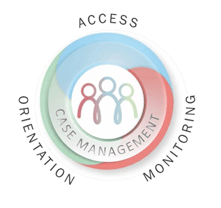Written by Dr. Robyn Sampson
Senior Advisor, International Detention Coalition
The program demonstrates that case management works in achieving immigration compliance at a tiny fraction of the fiscal cost of detention and without the human cost and cruelty of separating families or detention.
The Women’s Refugee Commission in the US has released a new evaluation of the Family Case Management Program, which operated in the United States between January 2016 and June 2017. This government-funded program was designed to test the effectiveness of tailored supervision with vulnerable families – such as pregnant women, nursing mothers, and families with special needs children – who were waiting for their immigration court hearings.
Holistic Case Management Approach
The program was designed on the basis that meeting basic needs, exploring all options in the individual case, and building trust would result in participants who were more ready, willing and able to comply with all aspects of the immigration process. The FCMP service framework involved three main components:
- Monitoring Individualised and interactive compliance monitoring with dedicated ICE Officers
- Low caseload ensures on-going supervision of cases and rapport with participants
- Access Access to community based services
- Facilitates community services individualised to participant needs through a professional trusting relationship
- Orientation Mandated orientation programming for participants
- FCMP staff and officers act as “system navigators”

Together, the three components served as a method to promote compliance while allowing participants to remain in their community as they moved through the immigration process.
The program was contracted by the government to GEO Care to provide holistic case-management services on an estimated 20:1 family unit to case manager ratio. This company then partnered with community-based social service and faith-based organizations to provide additional support services. In addition, GEO Care partnered with legal assistance programs to ensure clients access Know Your Rights presentations and other forms of basic legal information exchange. The head of household for each family was required to attend a legal orientation program providing information on their legal obligations, immigration proceedings and basic US laws.
Case managers worked with each family to develop a family service plan and to facilitate access to community services. This included support for participation in immigration processes, such as departure planning and preparation support, as well as referrals for legal, medical, food, education and other basic needs.
The program was offered in Baltimore/Washington, D.C.; Los Angeles; New York City/Newark; Miami; and Chicago. Each of the five locations was able to manage up to 160 family units, making for a total capacity of 800 family units across the program.
Outcomes
A total of 2,163 people – made up of 952 heads of household and 1,211 dependents – participated in the program. An internal evaluation by the main provider found the holistic case management approach produced strong results. The program recorded 93% attendance at legal orientation, 99% attendance at court proceedings, 97% program check-in compliance, and an 87% favourable rate when a participant was terminated from the program. The program also produced independent departures, and better coping and wellbeing outcomes for children and families. The program cost US$36 per day per family, compared with US$140 per person per day in adult immigration detention, and $798 per family in family detention. Further improvements identified during the WRC evaluation, as well as a longer program operation period, would have likely created even better outcomes.
Conclusion
The IDC’s body of research shows that There Are Alternatives that are effective, affordable, and humane. The US Family Case Management Program provides even further evidence that case management focused on meeting basic needs and providing trustworthy advice will result in high compliance rates, low costs, and less harmful alternatives to detention.
Further Reading
- Women’s Refugee Commission. 2019. The Family Case Management Program: Why Case Management Can and Must Be Part of the US Approach to Immigration. New York: WRC.
- GEO Care. 2017. Family Case Management Program: Summary report. GEO Care (on file with IDC)
- Loiselle, Mary F. 2016. “Geo Care’s new family case management program.” GEO World, 2-3. Accessed 23.03.2017 at http://www.geogroup.com/userfiles/1de79aa6-2ff2-4615-a997-7869142237bd.pdf
- Sampson, R., Chew, V., Mitchell, G., & Bowring, L. (2015). There are alternatives: A handbook for preventing unnecessary immigration detention (Revised). Melbourne: IDC.